Bushwalking with kids can be tricky in winter – Bibbulmun Track Foundation volunteer Jim Baker shares some tips on getting the best from day and overnight treks in the Perth Hills area.
Getting back to basics can be as simple as taking the family onto the Bibbulmun Track. There's no TV, no video games and no Facebook on this world-class walking trail. Instead, there's the wonder of hills to climb, forests to conquer and rivers to cross and, at day's end, there's time around the campfire (or the gas stove) eating marshmallows and food that isn't takeout, revelling in the feeling of an honest day's exertion.
Winter and spring are ideal for walking on the Bibbulmun. There's none of the baking summer conditions that can lead to dehydration, and rivers are flowing freely. In spring, the flowers appear and temperatures can be milder, but many prefer the colder, wetter days for bushwalking. Provided you pack the right gear, it's easy to be comfortable both day and night on the Bibbulmun, where huts dot the track at 20km intervals.
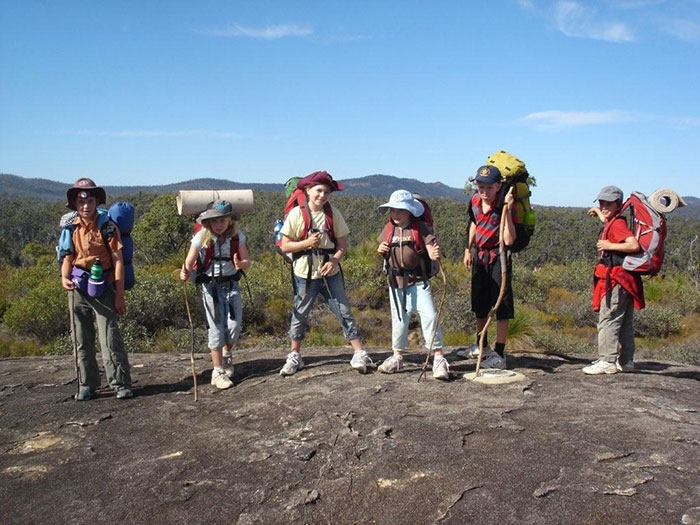
It's important to ensure that the kids' first experience of bushwalking is memorable for being good fun.
First things first
Planning your walk in advance is crucial. Get the Bibbulmun Track maps and guide books (from the Bibbulmun Track Foundation, DEC, visitor centres and bookshops) and be selective in choosing a section of track to walk.
Some sections are tougher than others — find something within your capabilities as a family. If your children's first introduction to bushwalking leaves them with acute memories of being cold, wet and tired, their interest may be destroyed forever. So plan in detail, and involve the kids in the discussion. Use the notes in the guide books to show them where you are taking them, and what they are likely to see.
Consider how you will get to the track. Access by car is limited, so study the maps – entry points are marked with red car symbols, which indicate places where the track crosses a road. You can park your car at these access points, although they are not car parks as such.
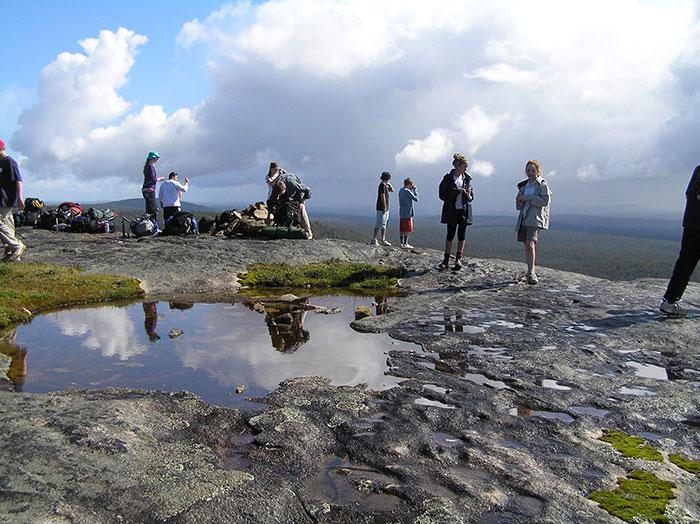
The Bibbulmun Track passes by any number of lookouts with spectacular views.
What to take
If you're planning an overnight stay, you'll need the right gear to be comfortable.
Backpack | Should be made as waterproof as possible, preferably with an external rain cover and also a strong plastic inner liner — a good strong rubbish bag is ideal, with the drawstrings pulled tight.
Sleeping bag | Rated down to zero degrees, with a hood with drawstrings.
Mattress | Preferably a self-inflating air mattresses of the Thermarest type. Air mattresses are far superior to foam rubber. They're more comfortable, and provide a layer of insulation between your sleeping bag and the hut's wooden floorboards.
Stove | The two most common types of stove are the meths-burning type (make sure you use methylated spirits and nothing else) and the gas cylinder type. With kids, the metho type is probably the best option, as these stoves come with a set of pots and a frying pan. With a gas stove you will need to carry separate cooking pots.
Food | Always consider weight when packing food. Avoid cans and bottles and dispose of as much packing material as you can before setting off. Remember: what you pack in, you must pack out. It's ideal if you can dehydrate the food yourself and prepare whole meals that you can reconstitute, but that might seem a bit daunting first time out. There are myriad dried foods available on the supermarket shelves that are suitable for walkers. It is important that you take food that you and your kids actually like. There's no fun in discovering that everybody detests the food you have carefully selected, but never tasted, so try some out at home first.
Water | In the winter there will be plenty of fresh water in the rain tanks at the campsites, but have the capacity to carry at least two litres of water per person when you are walking on the track. Kids often don't like water on its own, so take some flavourings in powder form to encourage them to drink. Hot drinks such as tea and coffee are standards, and powdered soups that require just the addition of hot water provide heat and nourishment.
Wet-weather gear | Rain jackets should be sitting at the top of your packs. The clothes that you are walking in must be lightweight and quick-drying. Kids tire quickly and lose their body heat very rapidly. Make very sure that their clothing and gear — especially their sleeping bags — are up to scratch. Keep their pack weights down to a minimum, even if that means Dad has to suffer the extra few kilos.
Extra tips | Carry a first-aid kit just to be on the safe side, check the weather forecast and take well worn-in footwear.
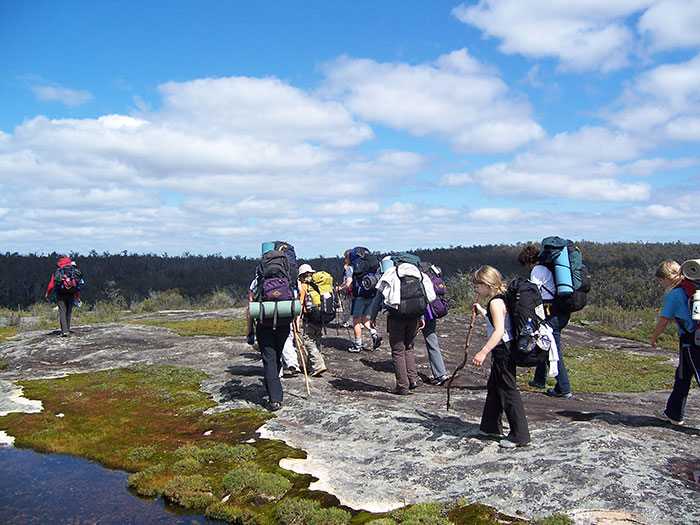
Think carefully about what to take – what you pack in, you must pack out.
Setting up camp
The walking part of the adventure handles itself – just follow the yellow signs and remember to stop and smell the eucalypts. It's the end of the day that takes some thinking about. There's no heaters, no TV and no microwave here.
So what is at the camp? A three-sided wooden shelter with a wooden floor to sleep on (that's why that air-mattress is a good idea). There are tables and benches to eat at, and in some places a fire-pit for your campfire. A short walk away, there's a sit-down, long-drop toilet (carry your own toilet paper!).
If you walk in the winter you will probably arrive wet and tired. You won't be especially cold; the effort of walking will have kept you warm enough. The trick is not to waste that warmth. Daylight hours are relatively short in the winter and it is better to get yourself set up before dark rather than by torchlight.
When arriving at the campsite make sure the kids are taken care of first — towelled as dry as possible and dressed in campsite clothing – thermal underwear, long pants, warm top (fleece), beanie and a Microlite towel and footwear such as crocs or sandals.
.jpg)
Hang your wet clothes to dry during the night. Set up your fuel stove, and make hot drinks — tea, coffee, soup or whatever. It is essential to carry a fuel stove with you. You may be able to light a fire but cooking over one is not recommended, especially if there are a lot of people trying to prepare their food at the same time – and, of course, it may be raining!
While you wait for the water to boil, set up your sleeping areas. Pick your spots in the shelter carefully. Make sure there are no leaks in the roof and check the direction of the prevailing wind to ensure you are in the most sheltered area. Set up your sleeping mats, spread your sleeping bags on top and use one of your stuffed bags of clothing as a pillow.
By now the water is boiling, so make hot drinks, sit back, relax and reflect on your day's walking. You are dry and warm and it is important to stay in that condition. If weather conditions allow, and you are in a campsite where fires are permitted, it is generally a good idea to get a reasonable-sized fire going, especially for the kids. Apart from heat, it gives a psychological boost. So light the fire and start cooking on your stove.
Food is a very individual choice but should be nutritious, as lightweight as possible (dehydrated, freeze-dried) and easily prepared. Once you have eaten, it is important to preserve warmth. A short time around the fire is fine, but don't allow yourself to get cold.
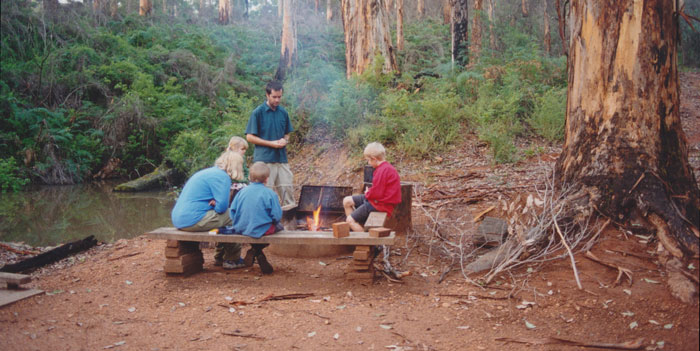
Beavis campsite
Come bed time, put out the fire and get into your sleeping bags while you still feel warm: a sleeping bag doesn't warm you, it retains the heat you've built up. The same applies to the clothes you wear in the bag. Proper thermals will keep you much warmer than heavy sweaters, and always wear a beanie — most body heat escapes through the top of your head. The digestion of your food creates warmth and if you are properly equipped and clothed you will enjoy a good night's sleep and be ready to tackle the next day's walking.
Hot food such as porridge in the morning maintains warmth and energy. Bring plenty of treats (bribes) such as chocolate and lollies, to help the journey back to your car.
For parents who have reservations about getting out there on their own, but still feel a desire to participate, the Bibbulmun Track Foundation has a great range of fully guided family events. See bibbulmuntrack.org.au for details. The Bibbulmun Track Foundation staff and volunteers are always willing to assist with queries about walking on the track at any time of the year. They also hire a range of equipment, and can offer advice on cooking on a fuel stove. Call (08) 9481 0551 for more information.
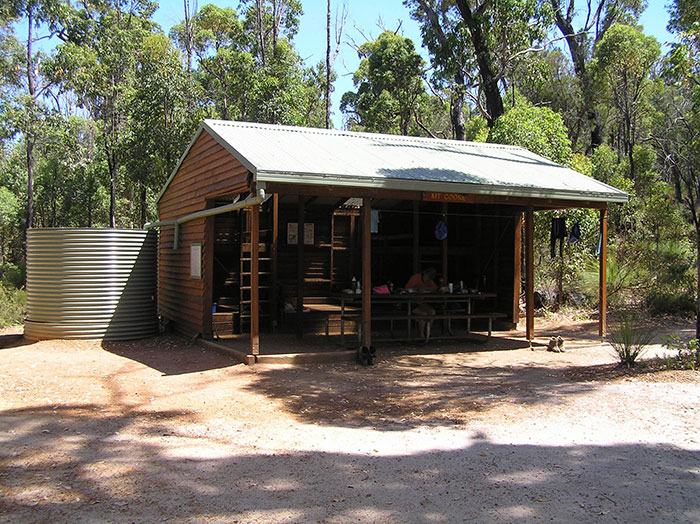
Mt Cooke campsite
SUGGESTED WALKS
Day walks in the Perth Hills area
Asher Road to Hewitt's Hill campsite | This is a great starter walk for real youngsters. Taking a picnic lunch in a day pack, leave the car at Asher Road outside Kalamunda where it intersects the track, and walk just a couple of kilometres to the campsite, and return.
South Ledge picnic site to Hewitt's Hill campsite | A slightly longer walk, perhaps for older kids. Park at the South Ledge picnic site and walk to Hewett's Hill campsite from the other direction, and return.
Overnight adventure
Sullivan Rock to Mt Cooke campsite (return) | Drive out of Perth on the Albany Highway and park in the picnic area opposite Sullivan Rock. Follow the Waugal trail markers across the rock to the Bibbulmun track, turn right and walk to the Mt Cooke campsite (about 6km). The next morning, climb to the top of Mt Cooke (the kids will probably get there first), enjoy the view, and then backtrack to the car.